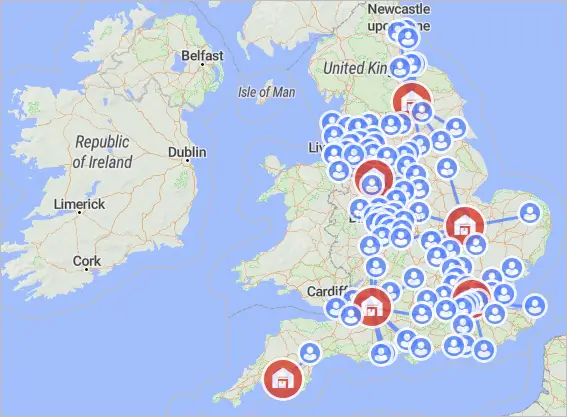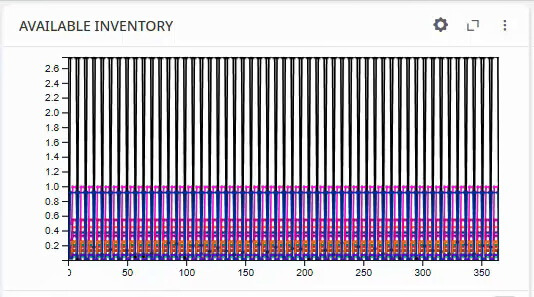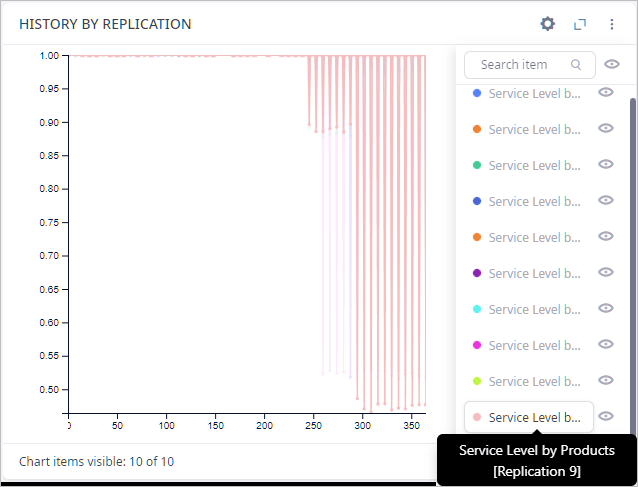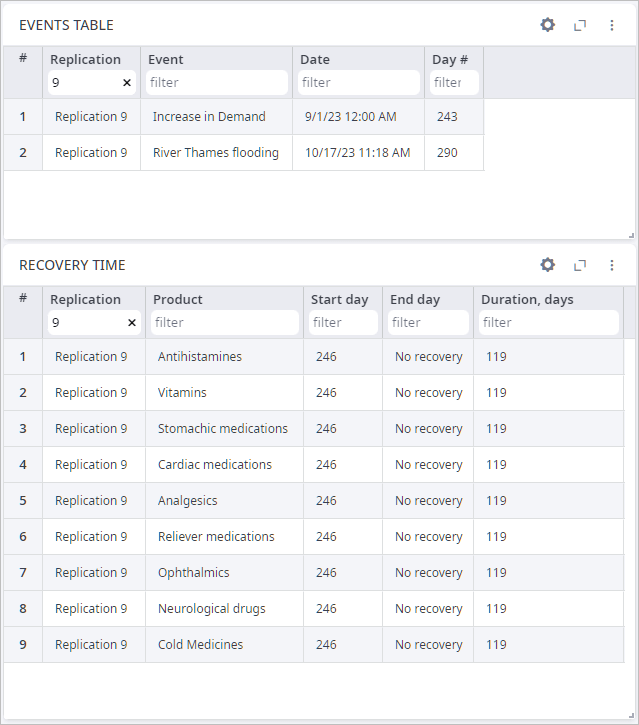Read also: Explore a case study of mobile vaccination clinics in Bali.

Effective cold supply chain management is essential for maintaining product integrity, ensuring timely deliveries, and minimizing supply chain costs. Businesses handling temperature-sensitive products face unique challenges, including high operational expenses, transportation risks, and regulatory compliance.
In this blog post, we explore key strategies for optimizing the cold supply chain using anyLogistix. From strategic warehouse placement to network optimization and simulation, discover how advanced supply chain planning can drive efficiency and cost savings.
Contents:
A cold supply chain (or cold chain) is a temperature-controlled supply chain used for storing, transporting, and distributing perishable goods. Maintaining precise temperature conditions is crucial for preserving product quality, safety, and compliance with regulations.
Cold chain logistics is critical for various sectors. The food and beverage industry relies on cold chains to maintain the quality of dairy, meat, seafood, frozen foods, and fresh produce. Pharmaceuticals and healthcare depend on temperature-controlled logistics for vaccines, insulin, and biologics, ensuring they remain effective. The chemicals and biotechnology sector requires stable conditions for temperature-sensitive chemicals and laboratory samples.
Managing a cold supply chain comes with unique challenges that require careful planning and robust risk management strategies. Some of the major challenges include:
Effective cold chain management involves strategic planning and optimization to reduce supply chain costs, minimize risks, and enhance service levels. The example below describes planning and optimizing a cold supply chain in anyLogistix software using such methods as greenfield analysis (GFA), network optimization, and supply chain simulation.
To demonstrate the solution to these challenges in the cold supply chain, let's explore a practical case study in anyLogistix.
For this example, we consider a supply chain in England that consists of 100 drugstores located in major cities. The drugstore chain’s executive management has decided to rent new facilities to support its cold supply chain. The demand for key pharmaceuticals, including antihistamines, vitamins, analgesics, and cardiac medications, is periodic in nature. Customers should be located within 100 km of the facilities to ensure timely deliveries.
To address the challenges of temperature control and proximity to suppliers, anyLogistix uses greenfield analysis. GFA is one of the best methods to identify the most cost-effective locations for warehouses or distribution centers by analyzing various critical factors: proximity to suppliers, transportation costs, last-mile delivery, and vehicle types (refrigerators).
For this example, the experiment results in anyLogistix suggest adding six new warehouses throughout England.
However, potential zones for warehouse locations may not be sufficient. To improve location accuracy, a GFA with roads experiment is run in anyLogistix. In this case, besides route distances, the site selection experiment accounts for road networks and city accessibility.

The result of the GFA experiment suggests adding six new warehouses to the cold supply chain throughout England
anyLogistix can further enhance cold supply chain planning by refining warehouse locations using network optimization. This experiment determines precise facility locations based on data obtained from the greenfield analysis results.
Network optimization considers the following factors to reduce supply chain costs:
Network optimization finds the optimal combination of facilities and flows between them, considering all the defined demand, constraints, supply chain costs, and other critical parameters specified in the problem definition.
Read also: Explore a case study of mobile vaccination clinics in Bali.
As the next step in cold supply chain planning and optimization, anyLogistix allows for the integration of a simulation experiment—a unique, unparalleled feature that sets anyLogistix apart.
A supply chain simulation models the behavior of a logistics network over time, providing dynamic details and deeper insights. It expands the design, analysis, and optimization toolkit for supply chain managers, allowing for more informed decision-making.
It also offers detailed statistics for each object in the supply chain, tracking its behavior over time. These statistics can be displayed in multiple formats and customized to align with specific business needs.
Simulation can be leveraged for what-if analysis, helping identify bottlenecks and understand how the supply chain performs over time. Additionally, simulation can be applied for safety stock estimation and risk analysis, ensuring better resilience and efficiency in the cold supply chain.
Another key advantage of simulation is multi-iteration experiments, which help achieve statistically significant results for more accurate decision-making.
In our anyLogistix example, the GFA results are converted into a simulation scenario to refine supply chain details:
Running the simulation experiment highlights issues in the supply chain. The result indicates insufficient service levels, while the Available Inventory chart reveals periods of product shortages. To address this, a safety stock estimation experiment is conducted, generating new inventory policies.

Available Inventory chart
Upon updating the inventory records and rerunning the simulation experiment, service levels improve significantly, with only minor backlogs remaining.
Even with improvements, supply chain operations remain vulnerable to risks and uncertainties. A simulation experiment in anyLogistix allows testing a supply chain against disruptive events such as strikes, contract terminations, facilities closure, production breakdowns or maintenance, sudden demand fluctuations, and natural disasters.
The list of risk factors in the Events table (click to enlarge)
Using the Events table in anyLogistix, uncertainties are integrated into the scenario. The variation experiment runs multiple simulations with stochastic parameters (e.g., demand, processing times, vehicle speeds) to analyze potential outcomes.
Variation experiment
The variation experiment in anyLogistix is a multi-iteration experiment designed to enhance supply chain analysis. Its primary use case is the ability to set a range of values for any parameters of any objects and execute a supply chain simulation, systematically looping through different values or combinations to assess their impact on supply chain behavior.
Additionally, for each varied parameter, the simulation can run multiple times (replications) to generate different values based on probability distributions, ensuring statistically significant insights. This approach enables businesses to analyze supply chain costs, performance variations, and risk factors, leading to more informed decision-making and optimized operations.
As a result, we obtain a time-dependent behavior that generates various stochastic values, allowing us to analyze the distribution of results and estimate minimum, maximum, and mean values for each parameter combination.
Results of the variation experiment:
There is a huge probability of events’ occurrence, and triggering these events leads to disruptions in the supply chain and its performance (click to enlarge)
Risk analysis experiment
A risk analysis experiment in anyLogistix assesses the impact of disruptions on the supply chain. In our example, the Target Service Level tab shows that certain replications experience severe service level declines. The replication with the index 9 has the worst daily change of service level.

History by Replication chart
The Recovery Time table indicates that the supply chain was unable to return to acceptable service levels after these events, highlighting the need for increased resilience.

Recovery Time table
Improving supply chain resilience
Based on the results of both experiment runs, we can assume that the required service level cannot be maintained by the supply chain in the current state. To mitigate risks, the company should consider:
By implementing these strategies, the cold supply chain can achieve greater robustness and maintain high service levels under uncertain conditions.
A cold supply chain plays a critical role in ensuring the safe and timely delivery of temperature-sensitive products. However, it presents unique challenges such as storage constraints, demand fluctuations, and supply chain disruptions.
anyLogistix provides a comprehensive toolkit to analyze and optimize cold supply chains using greenfield analysis, network optimization, and simulation experiments. Through these advanced techniques, companies can reduce supply chain costs, design resilient and efficient logistics networks, minimize risks, and improve service levels.